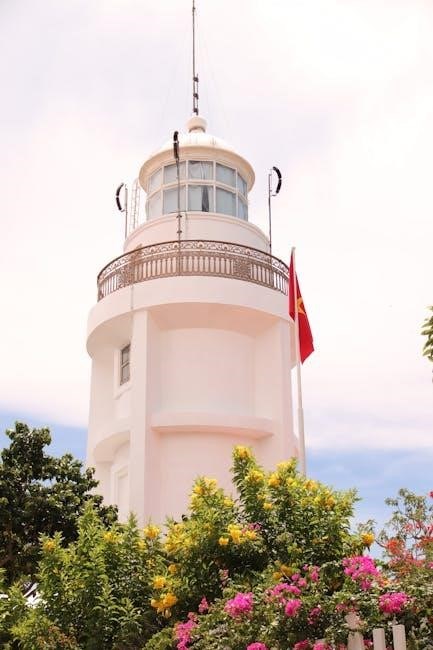Welcome to the Zone 7 planting guide, tailored for gardeners in USDA Hardiness Zone 7. This guide provides essential insights into the region’s mild winters, long growing season, and diverse planting opportunities.
Understanding the USDA Hardiness Zone System

The USDA Hardiness Zone System is a vital tool for gardeners, dividing North America into 11 zones based on average annual extreme minimum temperatures. These zones help determine which plants can thrive in specific regions. Zone 7, for instance, has average winter lows ranging from 0°F to 10°F (-17°C to -12°C), making it a moderate climate for growing a wide variety of plants. By understanding your hardiness zone, you can select plants suited to your local conditions, ensuring better growth and survival. This system is particularly useful for Zone 7 gardeners, as it allows them to make informed decisions about planting times and plant selection. While microclimates and soil conditions can influence plant performance, the USDA zone system provides a solid foundation for successful gardening. It’s an essential starting point for anyone looking to maximize their garden’s potential in Zone 7.
Climate Characteristics of Zone 7
Zone 7 is characterized by mild winters and warm summers, with average winter temperatures ranging from 0°F to 10°F (-17°C to -12°C). The growing season is relatively long, allowing gardeners to cultivate a wide variety of plants, including both cool-season and warm-season crops. The region typically experiences moderate precipitation, with rainfall distributed fairly evenly throughout the year. Summers are hot and humid, while winters are generally mild, making it an ideal zone for year-round gardening. The first frost date in Zone 7 is around mid-November, and the last frost date is in early to mid-April, providing a growing window of approximately 7 months. This climate diversity supports a broad range of plant species, from vegetables to flowers, and offers ample opportunities for gardeners to maximize their yield. Understanding these climate characteristics is essential for planning and maintaining a thriving garden in Zone 7.
How to Determine Your Specific Planting Zone
Determining your specific planting zone is crucial for successful gardening. The USDA Hardiness Zone Map is the primary tool for identifying your zone, as it divides regions based on average annual extreme temperatures. Zone 7, for instance, has average winter lows between 0°F and 10°F (-17°C to -12°C). To find your exact zone, visit the USDA’s interactive map online and enter your zip code or city name. Additionally, consider local microclimates, which can vary slightly from the general zone due to elevation, proximity to water, or urban heat islands. Understanding your specific frost dates is also key, as these determine when to plant or protect tender plants. For Zone 7, the last frost date is typically in early April, and the first frost occurs around mid-November. By combining this information with soil type and local weather patterns, you can refine your planting strategy for optimal results.
Zone 7 Planting Seasons
Zone 7 has two main planting seasons: cool-season crops in early spring and warm-season crops after the last frost. The growing season typically runs from April to November, offering ample time for multiple harvests.
Cool-Season Crops
Cool-season crops thrive in Zone 7’s mild winters and early springs. These plants prefer cooler temperatures and can tolerate light frosts, making them ideal for planting in late winter to early spring.
- Examples include spinach, radishes, lettuce, peas, and broccoli.
- These crops are typically planted 4-6 weeks before the last frost date, as they mature quickly.
- Some crops, like kale and cabbage, can even be planted in late summer for a fall harvest.
- Soil preparation is key, ensuring good drainage and fertility for optimal growth.
Starting seeds indoors and transplanting them later can also be effective for extending the growing season.
Warm-Season Crops

Warm-season crops in Zone 7 excel during the region’s hot summers, thriving in temperatures above 65°F. These crops are typically planted after the last frost date, which in Zone 7 is around early to mid-April.
- Common warm-season crops include tomatoes, peppers, cucumbers, squash, and corn.
- These plants require full sun and well-draining soil to maximize yields.
- Starting seeds indoors 4-6 weeks before the last frost date can give plants a head start on the growing season.
- Tomatoes and peppers benefit from being transplanted outside when the soil has warmed up sufficiently.
Zone 7’s long growing season allows for multiple harvests of warm-season crops, making it an ideal location for a diverse and productive garden.

Month-by-Month Planting Calendar
A month-by-month planting calendar is essential for Zone 7 gardeners to maximize their growing season. Zone 7’s mild winters and long growing season allow for year-round gardening with proper planning.
- January: Start seeds indoors for cool-season crops like broccoli and kale. Plan your garden layout and order seeds.
- February: Prepare soil by adding compost or fertilizer; Prune fruit trees and berry bushes.
- March: Plant cool-season crops such as spinach, radishes, and carrots. Begin hardening off seedlings started indoors.
- April: After the last frost date, plant warm-season crops like tomatoes and peppers. Direct sow beans and corn.
- May: Sow seeds for summer crops like cucumbers and squash. Fertilize established plants.
- June: Focus on maintaining plants, mulching, and controlling pests. Harvest spring crops.
- July: Continue harvesting summer crops. Plant heat-tolerant varieties like okra and southern peas.
- August: Start seeds indoors for fall crops like lettuce and spinach. Direct sow fall crops like kale and carrots.
- September: Plant cool-season crops for a fall harvest. Divide and replant perennials.
- October: Harvest fall crops and prepare the soil for winter. Plant garlic and cover crops.
- November: Clean up the garden and compost debris. Protect sensitive plants from frost.
- December: Plan next year’s garden and order seeds. Enjoy winter harvests like Brussels sprouts and kale.
This calendar ensures gardeners in Zone 7 make the most of their growing season, from spring to fall and even winter.

Best Plants for Zone 7
Zone 7 supports a wide variety of plants, including tomatoes, peppers, and squash for vegetables, and coneflowers, black-eyed susans, and hydrangeas for flowers. These plants thrive in its mild winters and long growing season.
Vegetables
Zone 7 gardeners enjoy a diverse range of vegetables due to the region’s favorable climate. Cool-season crops like spinach, radishes, and broccoli thrive in early spring, while warm-season crops such as tomatoes, peppers, and squash flourish in summer. Cabbage, beets, and carrots can be planted before the last frost. Tomatoes, zucchini, and cucumbers are popular choices for summer gardens. Fall brings opportunities to grow kale, spinach, and Brussels sprouts. Root vegetables like carrots and turnips can be harvested in late fall. With a long growing season, Zone 7 allows for multiple harvests, ensuring a bountiful yield. Proper planning and timing, based on the last frost date, are key to successful vegetable gardening in this zone.
Flowers
Zone 7 offers an ideal climate for a wide variety of flowers, with its mild winters and long growing season. Gardeners can enjoy both cool-season and warm-season blooms, ensuring vibrant color throughout the year. Annuals like marigolds, zinnias, and petunias thrive in Zone 7’s warm summers, while perennials such as coneflowers, black-eyed Susans, and daylilies return year after year. Spring bulbs like daffodils and tulips naturalize easily, providing early-season beauty. Cool-season flowers like pansies and violas can be planted in early spring or late summer for fall color. Zone 7’s moderate winters also allow for winter blooms from plants like cyclamen and snapdragons. Proper soil preparation and timely planting are key to maximizing flowering potential. Understanding the USDA Hardiness Zone system helps gardeners select flowers suited to Zone 7’s climate, ensuring a stunning and resilient floral display.

